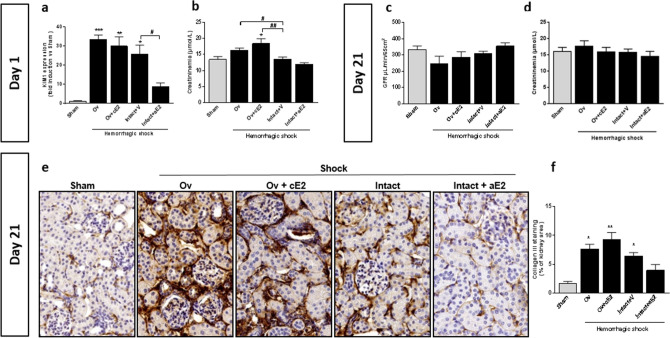Figure 2.
Renal impact at day 1 after hemorrhagic shock (a,b). (a) Tubular injury (KIM-1 mRNA expression, n = 6 for all groups), (b) Blood creatinine (n = 8 for sham and Intact, n = 7 for Ov, n = 6 for Ov + cE2 and n = 7 for Intact + aE2); Renal impact 21 days later (c–f). (c) Glomerular Filtration Rate measured by inulin clearance (n = 9 for sham and Intact, n = 6 for Ov, n = 5 for Ov + cE2 and n = 6 for Intact + aE2), (d) Blood creatinine (n = 6 for all groups), (e) Representative pictures of collagen III staining on kidney sections (magnification × 400, immunohistochemistry, counterstaining with hematoxylin), (f) Quantification of Collagen III expression (immunohistochemistry, n = 5 for each group). Sham: non-shocked mice; Ov: ovariectomized mice; Ov + cE2: ovariectomized mice with chronic estradiol substitution; Intact + V: Non ovariectomized mice receiving vehicle; Intact + aE2: intact mice receiving 25 µg of estradiol at the end of resuscitation. For KIM1 mRNA expression, relative mRNA expression levels were calculated using the ΔΔCtCt method, normalized to HPRT and β actin, and expressed as fold changes relative to the sham animals. Data are presented as mean ± s.e.m. *P < 0.05; **P < 0.01 and ***P < 0.001 versus sham; #P < 0.05 and ##P < 0.01 for indicated comparison.

